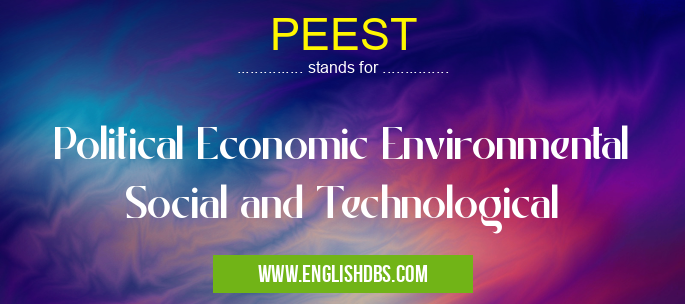What does PEEST mean in POLITICS
PEEST is an acronym that stands for Political, Economic, Environmental, Social, and Technological factors. It is a widely used analytical framework that helps organizations understand the external environment in which they operate. By analyzing these key factors, businesses can identify opportunities, mitigate risks, and make informed decisions that align with their strategic goals.

PEEST meaning in Politics in Governmental
PEEST mostly used in an acronym Politics in Category Governmental that means Political Economic Environmental Social and Technological
Shorthand: PEEST,
Full Form: Political Economic Environmental Social and Technological
For more information of "Political Economic Environmental Social and Technological", see the section below.
» Governmental » Politics
Political Factors
- Government Regulations: Policies and laws that impact business operations, such as taxation, labor relations, and environmental protection.
- Political Stability: The level of stability and predictability within the political system.
- International Relations: Trade agreements, tariffs, and geopolitical tensions that affect business activities.
Economic Factors
- Economic Growth: The rate of growth in the overall economy, which influences consumer spending and business investment.
- Inflation and Interest Rates: Changes in prices and borrowing costs that affect business profitability.
- Labor Market: Availability and cost of skilled labor.
Environmental Factors
- Climate Change: Regulatory policies and consumer demand related to reducing greenhouse gas emissions.
- Natural Disasters: Frequency and severity of natural events that can disrupt operations.
- Resource Availability: Access to raw materials, water, and energy.
Social Factors
- Demographics: Age distribution, income levels, and population growth rates.
- Culture: Values, beliefs, and attitudes that influence consumer behavior and business practices.
- Education and Healthcare: Levels of education and access to healthcare services.
Technological Factors
- Advancements in Technology: Innovations in fields such as artificial intelligence, automation, and communication.
- Technology Adoption: The rate at which businesses adopt new technologies.
- Regulatory Environment: Patenting laws, data privacy regulations, and intellectual property protections.
Essential Questions and Answers on Political Economic Environmental Social and Technological in "GOVERNMENTAL»POLITICS"
What is the PEEST analysis framework?
PEEST is an analytical framework that examines the impact of Political, Economic, Environmental, Social, and Technological factors on a business or industry. It helps organizations understand external factors that may affect their operations, strategies, and decision-making.
How is the PEEST framework used in business analysis?
PEEST is used to:
- Identify and assess external factors influencing a business
- Forecast industry trends and potential risks
- Develop strategies to mitigate risks and capitalize on opportunities
- Make informed decisions based on a comprehensive understanding of the business environment
What are the key components of the PEEST framework?
The five key components of the PEEST framework are:
- Political: Government policies, regulations, and laws that affect business
- Economic: Economic indicators, interest rates, inflation, and market demand
- Environmental: Environmental regulations, climate change, and resource scarcity
- Social: Cultural norms, demographics, and consumer behavior
- Technological: Technological advancements, automation, and research and development
How can businesses use the PEEST analysis to make better decisions?
By understanding the factors that influence their external environment, businesses can:
- Proactively identify potential challenges and opportunities
- Develop strategies to mitigate risks and maximize opportunities
- Make informed decisions based on a comprehensive understanding of the market landscape
- Adapt to changing circumstances and stay ahead of the competition
Final Words: PEEST analysis is an essential tool for businesses looking to gain a holistic understanding of their external environment. By considering the interplay between political, economic, environmental, social, and technological factors, organizations can identify potential risks and opportunities, anticipate future trends, and develop strategies that align with their mission and objectives. It is an ongoing process that requires regular monitoring and adaptation to stay abreast of the ever-changing external environment.
